 On October 28th, 1932, Benito Mussolini sat atop his horse, looked out over his newly built ‘Via dell’Impero’ (Road of the Empire) and smiled. He was about to lead the 1st parade down the grand avenue. These were good times for ‘Il Duce.’
On October 28th, 1932, Benito Mussolini sat atop his horse, looked out over his newly built ‘Via dell’Impero’ (Road of the Empire) and smiled. He was about to lead the 1st parade down the grand avenue. These were good times for ‘Il Duce.’
The 4 lane boulevard was a crowning achievement of Mussolini’s new ‘Third Rome.’ The 1st Rome was the Roman Empire from 8th century BC to 3rd century AD, the 2nd Rome was Constantinople from the 4th – 15th century.
Mussolini’s ‘Third Rome’ was the return to greatness. The newly built Via dell’Impero would unite the Monument of Vittorio Emanuele II in the Piazza Venezia to the Coliseum. It was an avenue that connected all the crowning achievements of Rome through the centuries.
The grand boulevard took 11 months the build. The well planned opening celebration coincided with the 10th anniversary of the 1922 March on Rome that brought Mussolini’s fascist party into power.
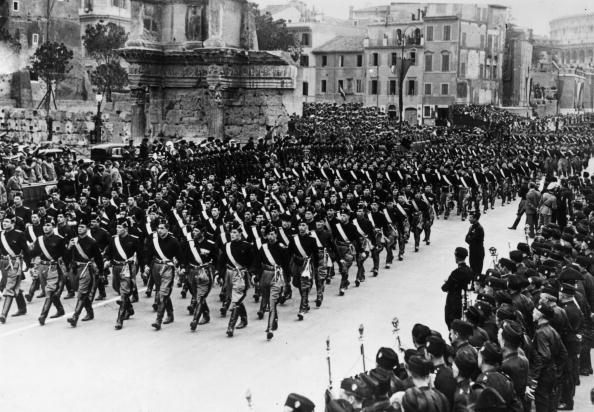 The 1932 parade even included 17,000 veterans of the 1922 March of Rome parading their Fascist black shirts proudly.
The 1932 parade even included 17,000 veterans of the 1922 March of Rome parading their Fascist black shirts proudly.
The name of the road changed to the ‘Via dei Fori Imperiali’ (Road of the Imperial Forums) in 1944, which is kind of ironic, since the new road actually destroyed the Imperial Forums it was named for.
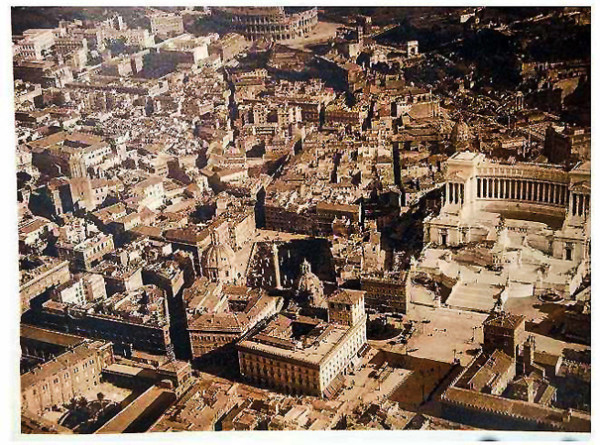 The new road removed over 80% of the Imperial Forums of Julius Caesar, Augustus, Nerva, Vespasian and Trajan. In the process, it also removed five Medieval Churches and destroyed over 40,000 square meters of one of the most densely populated sections of the city. Close to 5,000 residents of the area were relocated to the periphery of the city.
The new road removed over 80% of the Imperial Forums of Julius Caesar, Augustus, Nerva, Vespasian and Trajan. In the process, it also removed five Medieval Churches and destroyed over 40,000 square meters of one of the most densely populated sections of the city. Close to 5,000 residents of the area were relocated to the periphery of the city.
The photo above shows what the city looked like before the road was built.
The excavation for the road was done in such haste, archeologists didn’t really have enough time to categorize and label their findings. It was a mishmash of organization. Most of what they excavated was put into crates and buried in the basement of the newly built Museo della Civiltà Romana (Museum of Roman Civilization) in EUR (The Esposizione Universale Roma), Mussolini’s city of the future and failed 1942 World’s Fair.
The photo above shows what the area looked like after the buildings were destroyed to make room for the Via dell’Impero.
Some of the artifacts eventually found their way to the Capitoline Museum and the Museo Centrale Montemartini although the labels are unclear as to their origin. Basically, we really don’t know which forum they came from.
Mussolini even capped the project by installing Bronze statues of the Emperors who Forums he had destroyed. The statues of Julius Caesar, Augustus, Trajan and Nerva still decorate the grand boulevard.
There is no statue of Vespasian. There never was. Although Vespasian’s 70 AD Temple of Peace was paved over, Mussolini had no idea it was Vespasian’s Forum.
The Temple of Peace was built with the fabulous wealth taken in the victory over the Judean Rebellion of 69 AD. Much of the pillaged loot was supposedly stored in the Temple, including the golden menorah (supposedly made for Moses) that is still depicted in the inner panels of the Arch of Titus.
Although at the time, most people applauded the new road as a dramatic vision of the future and a wonderful retrospect of the great achievements of the ancient Empire.
After the fall of Mussolini, many just looked at the Via dei Fori Imperiali as the self-aggrandizing destruction of the ancient forums. However, Mussolini was hardly the 1st person to pillage or destroy the antiquities of Rome.
From the 4th through the 15th century, the Ancient Fori, were pillaged by everyone from Constantine the Great to Alaric and the Visigoths to the Church.
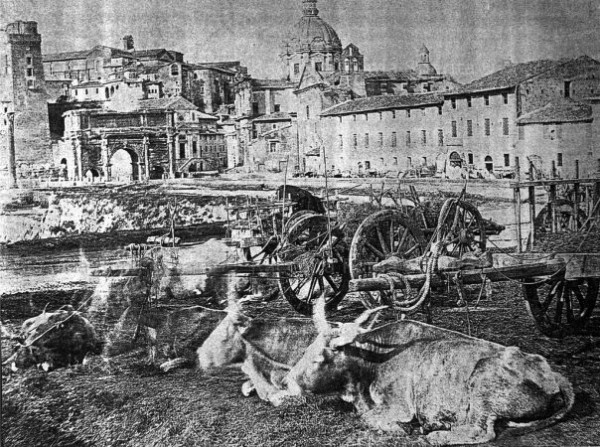 Over the years, close to 20’ of dirt, river silt and ancient debris buried much of Fori.
Over the years, close to 20’ of dirt, river silt and ancient debris buried much of Fori.
In the 15th and 16th centuries, the Ancient Roman Forum was known as the Campo Vaccino (Cow Pasture) because they was exactly what it was, a big cow pasture decorated with crumbling monuments of antiquity.
In the photo above you can see what the Forum looked like in 1856. The Arch of Septimius Severus is still buried under at least 12′ of debris.
The 18th century art historian, Johann Joachin Winkelmann is credited with the rebirth of interest in classical archeology but it wasn’t until 1802, during Napoleon’s occupation of Rome, that the restoration of the ancient city began.
Although Napoleon did take a lot of the antiquities back to France (they were later returned) he also began the restoration of what we now know as the ‘Roman Forum’ and the ‘Imperial Fori’.
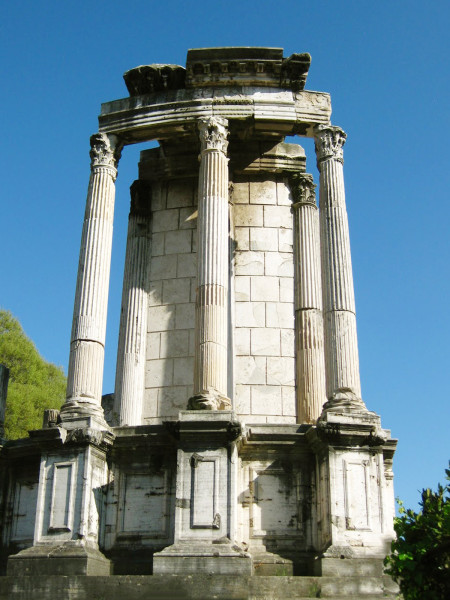
Mussolini might be chastised for destroying the Imperial Fori but he also restored many of the monuments.
Under the guiding eyes of the Italian architect Alfonso Bartoli, the reconstructions of the Temple of the Vestal Virgins (on the right) was completed in 1933. The Senate House (Curia) was rebuilt in 1935. In 1939, the back of the Capitoline Museum was cleaned of a stucco wall to reveal the Tabularium , the ancient Roman hall of records.
Although these reconstructions are based on some historical documentation and a lot of imagination, one really needs a lot of imagination when attempting to put the Roman Forums back to their rational shape. Over the years, many people have done just that.
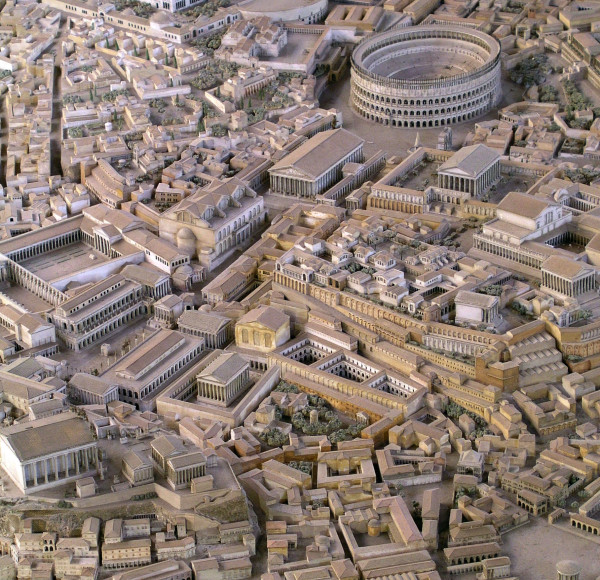
In 1935, under the direction of Mussolini, the Italian archeologist/architect, Italo Gismondi began his Opus Magnus. It took 35 years, but when it was finished, it was an amazing 3 dimensional (1:250 scale) model of the 4th century Ancient city of Rome.
The plaster model (known affectionately as ‘Il Plastico’) is still in the room where it was built, in the Museo della Civiltà Romana in EUR.
Gismondi completed the model in 1971. He died 3 years later.
Much of the information on the ancient city came from the few remains of the 2nd century marble map of Rome that once hung on the walls of the Temple of Peace. The wall that once held the marble map is now part of the Church of SS Cosmas and Damian that overlooks the Via dei Fori Imperiali.
Gismondi’s model is the same size as the 2nd century Temple of Peace map, 18 meters high x 13 meters wide.
Another interesting recreation of the Ancient Roman Forum is a miniature model built by Robert Garbisch, a fireman from Northern California.
Garbish, a passionate hobbyist built this amazing model between 1973 and 1982. In 1983 it was brought to Brandeis University. It’s still there.
The model gives you a glimpse of the Forum in 179 AD, during the reign of emperor Marcus Aurelius, complete with 350 statues and 270 Roman citizens.
These days you can find books of ancient Rome with recreations of how they looked in ancient times. They are by R.A. Staccioli and they are for sale at any tourist bookstore in Rome. These wonderful books are filled with color photos of what the monuments look like today with full color acetate overlays that fill in all of the missing information. You literally get to see the building as it is now and as it was then.
While Italo Gismondi was doing his research for ‘Il Plastico’, in 1934 Mussolini created his own marble and bronze maps showing the expansion of Rome from around 760BC to 1935 and beyond.
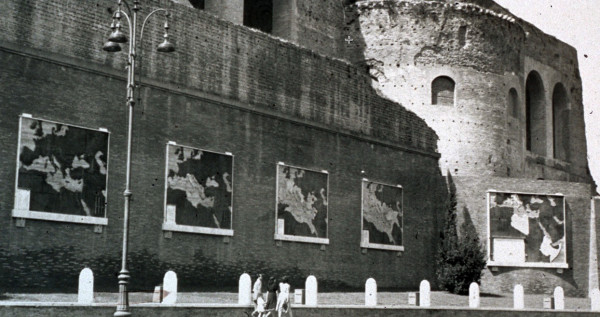 The first 4 maps, suspended from the exterior walls of the 4th century Basilica of Maxentius are still there.
The first 4 maps, suspended from the exterior walls of the 4th century Basilica of Maxentius are still there.
The 1st map shows the birth of Rome in the 8th century BC.
The 2nd map shows Rome in 146 BC, after the Punic Wars with Carthage. The 3rd map shows Rome during the reign of Augustus in 14 AD.
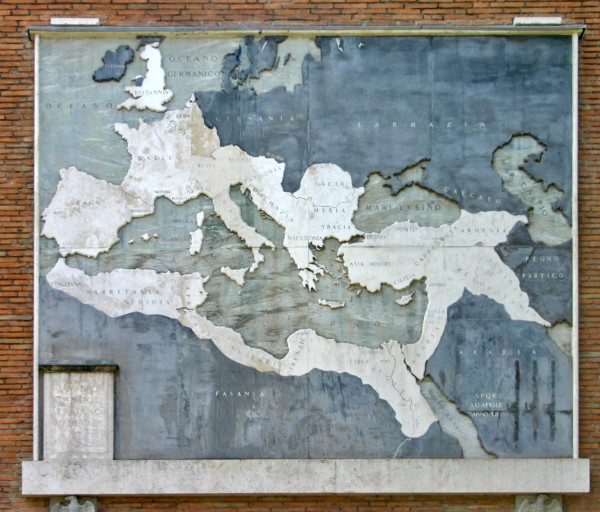 The 4th map shows the height of the Empire of Trajan in the 3rd century.
The 4th map shows the height of the Empire of Trajan in the 3rd century.
In 1935, Mussolini added a 5th map that showed the Italian expansion under Mussolini, including Ethiopia and future conquests of Turkey and the Middle East.
The 5th map is long gone, removed at some point between 1943 and the end of the war. It’s been stored in a basement in EUR for over 70 years.
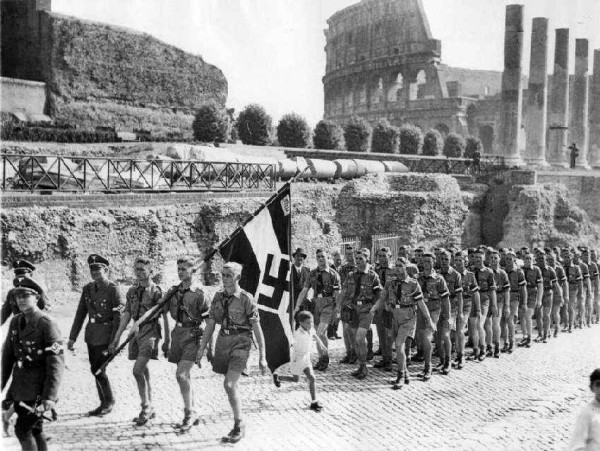 The Glory of Mussolini’s ‘Third Rome’ pretty much came to an end in 1943 when German forces invaded and occupied Rome.
The Glory of Mussolini’s ‘Third Rome’ pretty much came to an end in 1943 when German forces invaded and occupied Rome.
By that time Mussolini was a mess, both physically and mentally. In two years he would be killed trying to escape from Italy into Switzerland.
By 1945 the city was bombed into ruin and submission by Allied bombing.
Rome has been destroyed many times in it’s over 2,700 years and it always came back to life.
This time it was no different.
Within 8 years, thanks to Hollywood films like ‘Roman Holiday (1953) ’ and ‘Three Coins in a Fountain’ (1954), Rome once again became one of the most ‘romantic’ cities in the world.
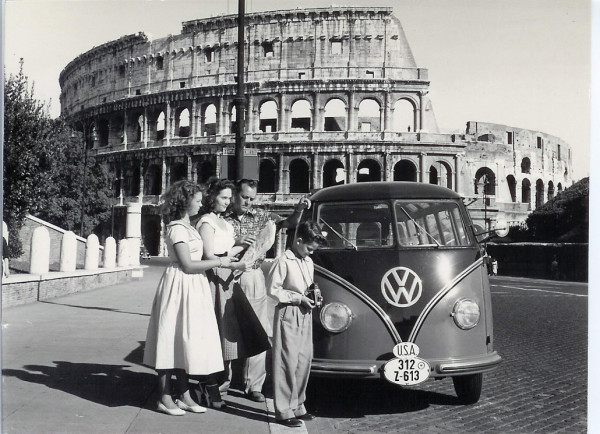 Tourism grew. The Via dei Fori Imperiali became one of the Grand Boulevards of Europe, on par with the Champs-Elysées of Paris, Regent Street of London, the Gran Via of Madrid or the Kurfürstendamm (Ku’Damm) of Berlin.
Tourism grew. The Via dei Fori Imperiali became one of the Grand Boulevards of Europe, on par with the Champs-Elysées of Paris, Regent Street of London, the Gran Via of Madrid or the Kurfürstendamm (Ku’Damm) of Berlin.
By the 1960’s it was a main thoroughfare of tour buses, taxis and cars.
The love affair between Italians and their cars began to choke the traffic and exhaust fumes began to blacken the once white marble monuments.
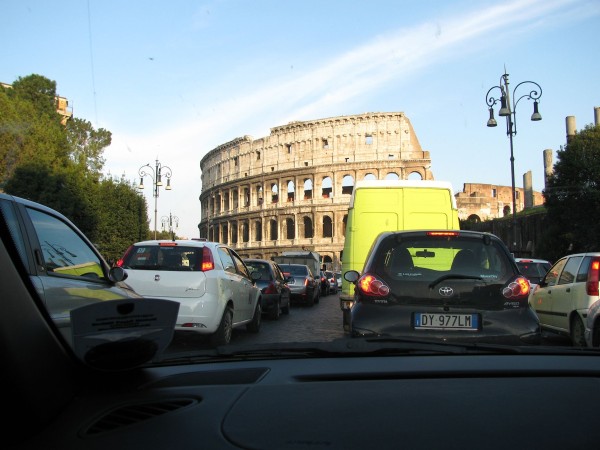 As of 2013, during the peak traffic hours, more than 1,600 vehicles passed along the Via dei Fori Imperiale every hour.
As of 2013, during the peak traffic hours, more than 1,600 vehicles passed along the Via dei Fori Imperiale every hour.
Rome had one of the worst traffic problems in all of Western Europe. 97% of the adult population of Rome owns a car (in London it’s 34%).
The streets of Rome are so congested, the average speed of traffic is 9 miles per hour.
In 2013, Ignazio Marino is one of most respected organ transplant specialists in the US and Italy became Rome’s 64th Mayor.
As a transplant Doctor, Ignazio Marino performed over 650 organ transplants including the transplant of 2 baboon livers into humans, which unfortunately didn’t work out so well.
In 2006 he transplanted himself back to Italy and won a seat in the Italian Senate.
In June 2013, after his election victory, his first official edict was to remove public traffic from the Via dei Fori Imperiali.
As of August 2013, the Via dei Fori Imperiali was closed to public traffic.
The citizens of Rome were up in arms. This was one of the main thoroughfares in the city. “How could he close this street without an alternative plan for the traffic flow”, they screamed.
The rerouting of all these cars and trucks hurt small businesses and annoyed the hell out of the inhabitants of the smaller streets neighborhoods now filled with unwanted traffic.
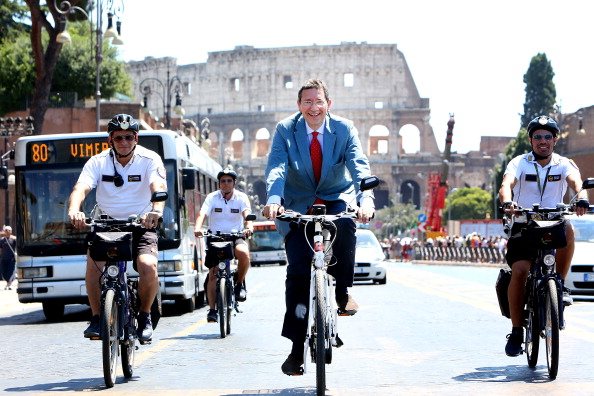 Mayor Marino’s response was that closing the Via dei Fori Imperiali was necessary to save the ancient monuments. It was the patrimonial responsibility of Rome.
Mayor Marino’s response was that closing the Via dei Fori Imperiali was necessary to save the ancient monuments. It was the patrimonial responsibility of Rome.
The rumbling pollution of 80 years of trucks, buses and cars has taken a toll on the monuments. The Coliseum Metro B line has added to the destruction by rocking the foundations of the great Amphitheater since the 1950’s.
The Mayor encouraged all Romans to leave their cars at home, use public transport or improve their health and walk or use a bicycle.
Mayor Marino travels almost everywhere in the city on his maroon bicycle, in all weather; rain, heat spells or even snow.
He was recently requested to give up the bike after numerous death threats but he refused. He now rides with a police escort (also on bicycles).
Mayor Marino’s replacement for the Via dei Fori Imperiali is the new Metro C line, currently under construction and hopefully opening in 2020.
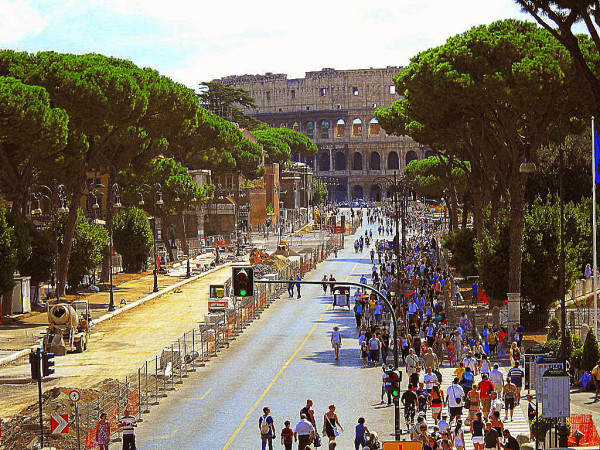 Currently, the street is closed to cars, tour buses and motorbikes but still open to taxis, chauffeured cars and municipal buses while the new Metro C line is being built under the street.
Currently, the street is closed to cars, tour buses and motorbikes but still open to taxis, chauffeured cars and municipal buses while the new Metro C line is being built under the street.
It is not clean whether taxis and municipal buses will still have use of the road after Metro C opens.
The Metro C Station at the Coliseum will also include a museum of all the pieces discovered during the dig.
This is of the reasons the new Metro is taking such a long time. Whenever you dig into the streets of an ancient city you have stop (a lot) to let the archeologists remove everything of historical value. Archeologists have not had an opportunity to see what is under the Via Fori dei Imperiali since the 1930s.
When Athens extended their Metro system in advance of the 2004 Summer Olympic Games, it took over 6 years to built the new stations because of all the archeological stops and starts.
Over 30,000 objects of historical importance from the 8th to the 4th century BC were discovered and are now on display in the newly built Athens metro stations.
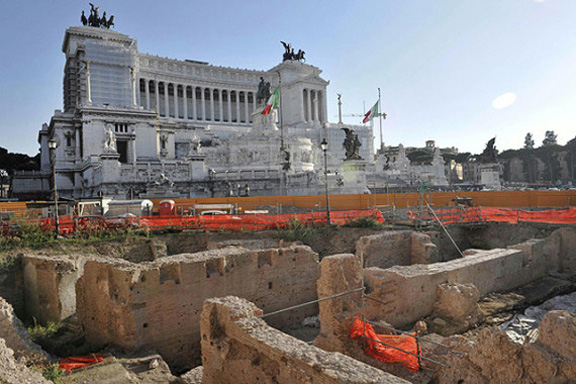 In 2009, the while excavating under the Piazza Venezia, workmen discovered the remains of Emperor Hadrian’s 2nd century Athenaeum, a school for Intellectuals. The Athenaeum was all but forgotten, once covered with Renaissance Palazzi in Piazza Venezia. It was later paved over after the construction of the 1885 ‘Altare della Patria’ (Altar of the Fatherland), the Italian glorification Monument dedicated to King Vittorio Emmanuele II.
In 2009, the while excavating under the Piazza Venezia, workmen discovered the remains of Emperor Hadrian’s 2nd century Athenaeum, a school for Intellectuals. The Athenaeum was all but forgotten, once covered with Renaissance Palazzi in Piazza Venezia. It was later paved over after the construction of the 1885 ‘Altare della Patria’ (Altar of the Fatherland), the Italian glorification Monument dedicated to King Vittorio Emmanuele II.
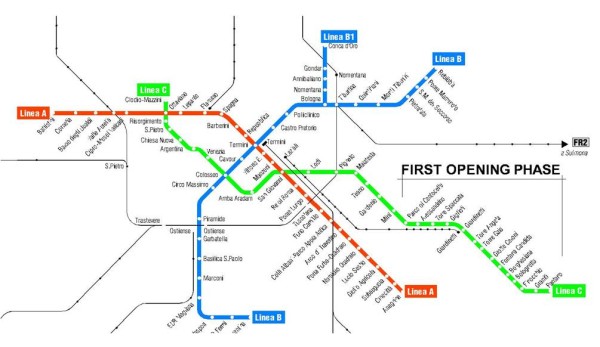 Metro C will connect Rome’s existing metro system to the Central historical zones, connecting St John in Laterano to the Coliseum, Piazza Venezia, Largo Argentina and St Peters.
Metro C will connect Rome’s existing metro system to the Central historical zones, connecting St John in Laterano to the Coliseum, Piazza Venezia, Largo Argentina and St Peters.
While this is a great convenience for tourists, Roman citizens are still wondering if it’s worth the inconvenience and cost, although Metro C also connect central Rome to the Alban Hills suburbia about 20km east of the city.
Just to give you an idea of the cost of this project, it’s a 10-12 minute walk from the new Coliseum Metro C station to the new Metro C station in Piazza Venezia. The cost is estimated at over 300 million euros.
Roman citizens are also wondering if the vibrations from the construction of Metro C are actually worse than the traffic it removed.
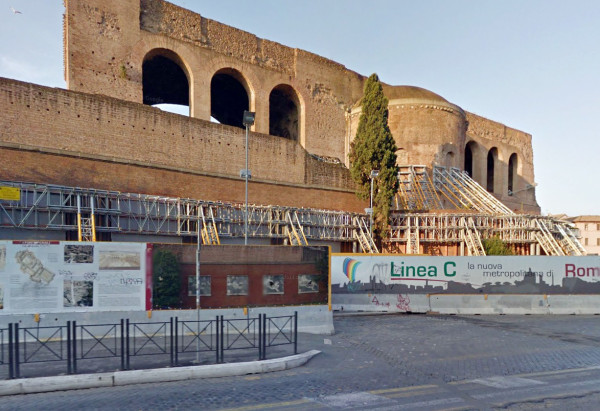 The city is doing it’s best to protect what it can. These days, the ancient Basilica is supported by large shock absorber bracing to protect it from the rumbling of earth digging equipment building the Metro C below.
The city is doing it’s best to protect what it can. These days, the ancient Basilica is supported by large shock absorber bracing to protect it from the rumbling of earth digging equipment building the Metro C below.
Oh by the way, after Metro C is completed, work will begin on Metro D.
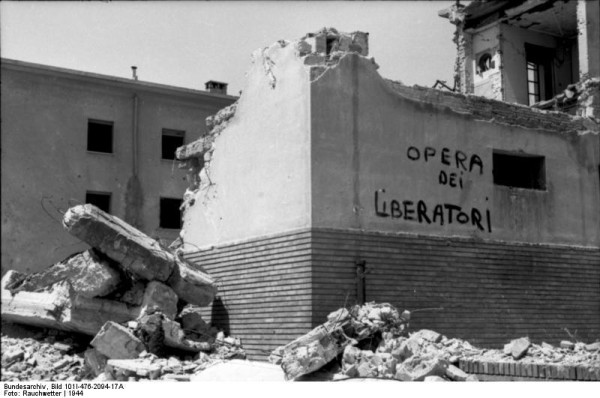
You must be logged in to post a comment.